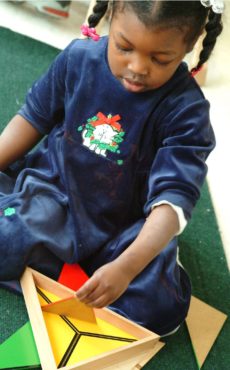
AMI pedagogical standards maintain the level of excellence that Maria Montessori envisioned. Established by the AMI Scientific Pedagogy Group, the standards ensure that each school offers programs for their children that allow for their full intellectual, social, physical, and psychological growth.
Philosophical Approach
A philosophical approach consistent with what is presented in AMI training courses worldwide.
“Our care of the child should be governed not by the desire to ‘make them learn things’, but by the endeavor always to keep burning within them the light which is called intelligence.” Dr. Maria Montessori
The Teacher
There will be one AMI teacher trained at the appropriate age level in each class. In an all-day class there may be two overlapping AMI trained teachers.
“We must support as much as possible the child’s desires for activity; not wait on him, but educate him to be independent. It is necessary for the teacher to guide the child without letting him feel her presence too much, so that she may always be ready to supply the desired help, but may never be the obstacle between the child and his experience.” Dr. Maria Montessori
The Assistant
Each primary and elementary class may have one non-teaching assistant. The classroom assistant should support the teacher by making materials, noting observations, supervising outdoor activities, and assisting with “going-outs.” At the assistants to infancy level, the adult to child ratio should be 1 to 3 for the Nido and 1 to 5 for the Infant Community.
The Materials
In order to ensure a prepared environment that is consistent with AMI standards, each Montessori classroom must be equipped with a complete set of Montessori materials. These materials should be purchased from an AMI authorized manufacturer. A “complete” set of Montessori materials is all materials needed by AMI trained lead teachers to present the lessons in their albums in the way that their training intended. Materials beyond the scope of the AMI teacher’s training may be considered extraneous with a requirement for them to be removed.
“The fundamental fact in the preparation of the environment is to have only one set of each type of material. When there is only one specimen of each object, and if a piece is in use when another child wants it, the latter will wait for it to be released. Since this happens every hour of the day for years, the idea of respecting others, and of waiting one’s turn, becomes a habitual part of life which always grows more mature.” Dr. Maria Montessori
The following companies manufacture materials according to detailed blueprints provided by AMI:
NOTE: Not all of the materials in these companies’ catalogs are AMI-approved materials. Look for the AMI logo for those approved by AMI.
AMI Digital provides a large range of digital Montessori materials including charts, classified cards and publications. The materials are available free to download.
Number of Children
Classes include a well-balanced division of ages as well as an appropriate number of children to ensure social development:
| Nido: 1 to 9/10 children | Infant Community: 10 to 14 children |
| Primary: 24 to 35 children | Elementary: 24 to 35 children |
“When classes are fairly big, differences of character show themselves more clearly and wider experiences can be gained.” Dr. Maria Montessori
AMI advocates for large numbers of children per class whenever possible as part of an ideal Montessori Prepared Environment but recognizes that schools may not always be able to achieve the recommended minimum number in each environment. In these circumstances full recognition may still be granted if the Recognition Consultation determines that the expected outcomes are present, and the environment is otherwise functioning in ways which warrant recognition.
Age Range
Classes include a well-balanced division of ages to ensure social development (ages listed are approximate):
| Nido: 2 months to 12/15 months | Infant Community: 12/15 months to 2.5/3 years |
| Primary: 2.5/3 to 6 years | Elementary: 6 to 9, 9 to 12, or 6 to 12 years |
“There are many things which no teacher can convey to a child of three, but a child of five can do it with the utmost ease. To understand what the older ones are doing fills the little ones with enthusiasm. There is a communication and a harmony between the two that one seldom finds between the adult and the small child.” Dr. Maria Montessori
Uninterrupted Work Periods
Classes are scheduled five days per week (unless specified otherwise) with substantial uninterrupted work periods every day:
- Nido: none required
- Infant Community: 2 hour uninterrupted work periods every morning
- Primary: 3 hour uninterrupted work periods 5 mornings per week, 2 hour uninterrupted work periods 5 afternoons per week
- Elementary: 3 hour uninterrupted work periods 5 mornings per week, 2-3 hour uninterrupted work periods every afternoon. One session per week either morning or afternoon may be left free to accommodate additional subjects.
“Left to themselves, the children work ceaselessly; they do not worry about the clock … after long and continuous activity the children’s capacity for work does not appear to diminish, but to improve.” Dr. Maria Montessori
